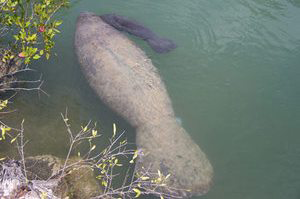The manatee's diet is mainly submergent, emergent, and floating vegetation, but the diet varies with plant availability and opportunistically may include other foods (e.g., acorns in early winter in Florida).
Photo Credit: J.C. Mikula
Trichechus manatus
Common Name: West Indian manatee
Animal Guild: Mammal
Class > Order > Family: Mammalia > Sirenia > Trichechidae
What does the species look like?
This is a slow-moving mammal with a rounded body, gray to brown skin with fine sparse hair, small head, squarish snout with a deeply split upper lip, valvular nostrils, small eyes, flexible flippers, and a large rounded horizontally flattened tail. Adults usually are about 10-13 feet (300-400 cm) in total length. Newborn calves are about 3-4 feet (1 meter) long.
Where is the species found?
States & Provinces
AL, FL, GA, LA, MS, NC, SC
Distribution
Range encompasses rivers, estuaries, and coastal areas of subtropical and tropical areas of northern South America, West Indies/Caribbean region, Gulf of Mexico, and southeastern North America (mainly Florida).
In Florida, manatees occur in freshwater, brackish, and marine environments. Typical habitats include coastal tidal rivers and streams, freshwater springs, and coastal seagrass beds. Manatees are not averse to traveling through dredged canals or using quiet marinas. Feeding often occurs in shallow grass beds with ready access to deep channels. Manatees drink from springs and freshwater runoff sites. Mating, calving, and care of young often occur in secluded canals, creeks, embayments, and lagoons.
General Phenology and Life History
In North America north of Florida, this species is mainly a migrant or irregular visitor. In Florida, manatees may migrate southward for winter; seasonal migrations of up to 530 miles (850 kilometers) to wintering areas have been documented, and migrations of 125-190 miles (200-300 kilometers) are usual along the Atlantic coast. This species exhibits a promiscuous mating system. Gestation lasts about 12-14 months. One young (rarely 2) is born in spring/early summer (usually). Young are weaned in 1-2 years. The interval between successive births for an individual female is 3-5 years (though 2 years if the calf is lost early). Newly mature individuals often do not successfully rear young.
Which phenophases should I observe?
Do you see/hear...?
Activity
Live individuals More...
For abundance, enter the number of individual animals observed in this phenophase.
Feeding For abundance, enter the number of individual animals observed in this phenophase.
Reproduction
Mating For abundance, enter the number of individual animals observed in this phenophase.
Development
Young individuals For abundance, enter the number of individual animals observed in this phenophase.
Dead individuals For abundance, enter the number of individual animals observed in this phenophase.
What do these phenophases look like?
There is currently no photoguide available for this species. If you'd like help us create one, use the guidance document and species template provided here . Then send it via email to education@usanpn.org when it is complete.
